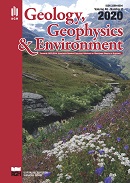Ophiuroids from the Middle Triassic (Muschelkalk) of Sadowa Góra, Jaworzno (southern Poland)
DOI:
https://doi.org/10.7494/geol.2020.46.2.175Keywords:
Middle Triassic, Muschelkalk, ophiuroids, Poland.Abstract
Ophiuroids belonging to Aspiduriella sp., Aspiduriella similis (Eck), and Arenorbis sp. are described from the Middle Triassic (Muschelkalk) strata of the Sadowa Góra Quarry (Jaworzno) in southern Poland. This is the only Polish location where three taxa of these ophiuroids have been found in one stratigraphic horizon (1st Wellenkalk). To date, only single taxa have been found in the Triassic sections of the eastern part of the Germanic Basin. Finally, other ophiuroid mass aggregations also known from Poland are presented.Downloads
References
Agassiz L., 1835. Prodrome d’une Monographie des Radiaires ou Echinodermes. Mémoires de la Société des Sciences naturelles de Neuchâtel, 1, 168–199.
Aronson R.B., 1992. Biology of a scale-independent predator-prey interaction. Marine Ecology Progress Series, 89, 1, 1–13.
Assmann P., 1914. Beitrag zur Kenntnis der Stratigraphie des oberschlesischen Muschelkalks. Jahrbuch der Königlich Preußischen Geologischen Landesanstalt, 34, 1, 268–340.
Boczarowski A. & Salamon M.A., 2000. Kompletne wężowidła jako wskaźnik warunków sedymentacji warstw gogolińskich Górnego Śląska. [in:] Historia basenów sedymentacyjnych a zapis paleontologiczny: XVII konferencja paleontologów: 21–23.IX.2000 Kraków, AGH, Kraków, 20–21.
Bojkowski K., 1955. Dolny wapień muszlowy w okolicy Szczakowej. Biuletyn Instytutu Geologicznego, 97, 229–270.
Bolette D.P., 1998. Taxonomic note: Aspiduriella nom. n. for the genus Aspidura Agassiz, 1835 (Echinodermata: Ophiuroidea: Ophiuridae); preoccupied by AspiduraWagler, 1830 (Reptilia: Serpentes: Colubridae). Journal of Paleontology, 72, 2, 401–402.
Eck H., 1865. Über die Formationen des bunten Sandsteins und des Muschelkalks in Oberschlesien und ihre Versteinerungen. J.F. Starcke, Berlin.
Gorzelak P. & Salamon M.A., 2013. Experimental tumbling of echinoderms-taphonomic patterns and implications. Palaeogeography, Palaeoclimatology, Palaeoecology, 386, 569–574.
Gray J.E., 1840. A synopsis of the genera and species of the class Hypostoma Asterias (Linn.). Annals and Magazine of Natural History, 6, 275–290.
Hagenow F. von, 1846. Aspidura Ludeni. Paläontographica, 1, 21–22.
Hess H., 1965. Trias-Ophiuren aus Deutschland, England, Italien and Spanien. Mitteilungen der Bayerischen Staatssammlung für Paläontologie und Historische Geologie, 5, 2, 151–177.
Hess H., 1970. Ein neuer Schlangenstern (Aplocoma mutatan.sp.) aus dem Hettangien von Ceilhes (Hérault) und Bemerkungen über “Ophioderma” squamosa aus dem Muschelkalk. Eclogae Geologicae Helvetiae, 63, 3, 1059–1067.
Kutscher F., 1940. Ophiuren-Vorkommen im Muschelkalk Deutchlands. Zeitschrift der Deutschen Geologischen Gesellschaft, 92, 1, 1–18.
Lamarck J.-B., 1816. Histoire naturelle des animaux sans vertèbres, présentant les caractères généraux et particuliers de ces animaux, leur distribution, leurs classes, leurs familles, leurs genres, et la citation des principales espèces qui s’y rattachent. Tome second. Verdière, Paris.
Ljungman A.V., 1867. Ophiuroidea viventia hucusque cognita enumerat. Öfversigt af Kongliga Vetenskaps-Akademiens Förhandlingar, 23, 9, 303–336.
O’Hara T.D., Hugall A.F., Thuy B., Stöhr S. & Martynov A., 2017. Restructuring higher taxonomy using broad-scale phylogenomics: The living Ophiuroidea. Molecular Phylogenetics and Evolution, 107, 415–430.
Piotrowski A., 1986. Ophioderma squamosum (Picard, 1858). [in:] Malinowska L. (ed.), Geology of Poland. Vol. 3. Atlas of guide and characteristic fossils. P. 2a, Mesozoic, triassic, Wydawnictwa Geologiczne, Warszawa, 56–58.
Piotrowski A. & Liszkowski J., 1981. Występowanie wężowideł w wapieniu muszlowym Wyżyny Śląsko-Krakowskiej. [in:] Fauna i f lora triasu obrzeżenia Gór Świętokrzyskich i Wyżyny Śląsko-Krakowskiej. Materiały V Krajowej Konferencji Paleontologów, Kielce-Sosnowiec, 58–60.
Radwański A., 2002. Triassic brittlestar beds of Poland: a case of Aspiduriella ludeni (v. Hagenow, 1846) and Arenorbis squamosus (E. Picard, 1858). Acta Geologica Polononica, 52, 4, 395–410.
Salamon M.A., 2004. High-density populations of the Triassic ophiuroid Aspiduriella similis (Eck) from the Holy Cross Mountains (central Poland): a preliminary report. Freiberger Forschungshefte Paläontologie, Stratigraphie, Fazies, C502, 12, 1–14.
Salamon M.A. & Boczarowski A., 2003. The first record of Aspiduriella (Ophiuroidea) in the Upper Muschelkalk of Poland. Geological Quarterly, 47, 3, 307–310.
Salamon M.A. & Niedźwiedzki R., 2005. An explanation for low endemism of Triassic crinoids from the epicontinental Germanic Basin, Poland. Geological Quarterly, 49, 3, 331–338.
Salamon M.A. & Zatoń M., 2004. Masowe nagromadzenia artykułowanych szkieletów wężowideł w osadach środkowego triasu Górnego Śląska i ich implikacje tafonomiczne. Przegląd Geologiczny, 52, 10, 997–1001.
Salamon M.A., Niedźwiedzki R. & Walter R., 2003. New data on Middle Triassic echinoderms from the Sudetes Mountains. Geological Quarterly, 47, 2, 133–139.
Salamon M.A., Chećko A. & Kędroń K., in press. Unikatowa fauna stenohalinowa z osadów środkowotriasowych kamieniołomu Sadowa Góra (Jaworzno). Przyroda Górnego Śląska.
Stöhr S., O’Hara T.D. & Thuy B., 2012. Global Diversity of Brittle Stars (Echinodermata: Ophiuroidea). PLOS ONE, 7, e31940.
Surmik D., Skreczko S. & Wolny M., 2014. The results of palaeontological excavations in the Sadowa Góra quarry (2012-14). Contemporary Trends in Geoscience, 3, 91–10 0.
Thuy B. & Stöhr S., 2018. Unravelling the origin of the basket stars and their allies (Echinodermata, Ophiuroidea, Euryalida). Scientific Reports, 8, 8493.
Zatoń M., Salamon M.A., Boczarowski A. & Sitek S., 2008. Taphonomy of dense ophiuroid accumulations from the Middle Triassic of Poland. Lethaia, 41, 1, 47–58.
Downloads
Published
Issue
Section
License
Authors have full copyright and property rights to their work. Their copyrights to store the work, duplicate it in printing (as well as in the form of a digital CD recording), to make it available in the digital form, on the Internet and putting into circulation multiplied copies of the work worldwide are unlimited.
The content of the journal is freely available according to the Creative Commons License Attribution 4.0 International (CC BY 4.0)










